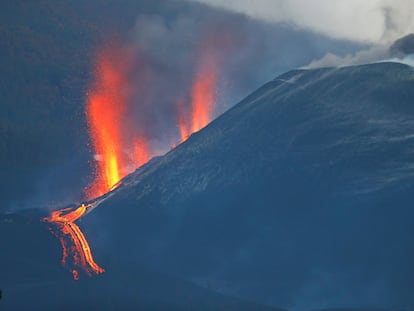Advancing lava from La Palma volcano poses new threat to La Laguna neighborhood
Experts are hoping that the molten rock will come to a stop before it further damages an area that has been evacuated three times already
The volcano on La Palma, in Spain’s Canary Islands, is once again posing a threat to a neighborhood that has already been evacuated on three different occasions since the eruption began on September 19.
There are around 1,200 registered residents in La Laguna, which is part of the municipality of Los Llanos de Aridane on the western side of the island, where a volcanic eruption has been taking place for 73 days now with no signs of letting up.
One of the two new eruptive vents detected last weekend on the volcano’s northeast side is spewing lava that is now flowing in an east-west direction and affecting previously spared forests and cropland, said María José Blanco, the scientific spokesperson for the team of experts monitoring the eruption, the Volcano Risk Prevention Plan of the Canary Islands (Pevolca).
The volcano’s eruptive activity has now moved from the main cone to this new secondary one, said Itahiza Domínguez, a seismologist with the National Geographic Institute (IGN), in a message on Twitter.
Fotografía tomada desde el centro de Los Llanos de Aridane esta noche / Photograph taken from the center of Los Llanos de Aridane tonight pic.twitter.com/4OMtYngHYV
— INVOLCAN (@involcan) November 29, 2021
Although Blanco said that lava emission has been “notably reduced” in recent hours, one of the channels of molten rock is moving over and past existing lava layers and could potentially reach La Laguna, which is located just 1.5 kilometers away.
Pevolca technical director Miguel Ángel Morcuende said that experts hope this new lava tongue will either “climb” on top of existing layers or come to a halt altogether. “This seems like the most reasonable outcome, considering the amount of solid matter it has picked up in its path.” The fact that the eruptive vent is producing less lava than in previous days is also a positive factor because “these lava flows need a lot of push from behind.”
More earthquakes
Nearly 100 tremors were recorded by the IGN in the early hours of Monday and up to 2.40pm, making it the day with the most seismic activity since November 17. A magnitude-5 quake was detected at a depth of 35 kilometers, the second strongest one since the tremor of November 19, which measured 5.1 on the Richter scale.
The spike in seismic activity began on Sunday, when there were 136 quakes. Earthquakes are one of the indicators used by scientists to estimate how long an eruption might last, along with sulfur dioxide emissions (SO₂) and vibrations caused by the flow of gas and magma, both of which have been showing higher values in recent days. Experts now believe that the volcanic activity that began on September 19 has a good chance of becoming La Palma’s longest eruption in 500 years.
The ongoing eruption, which is taking place on the western face of a mountain range that cuts down the middle of La Palma, will also go down in the history books as the one that caused the most damage on an island with a registered population of around 82,000. So far the lava has covered more than 1,000 hectares of land, and local property records show that the molten rock has destroyed nearly 1,500 buildings, most of them residential. Around 7,000 evacuated people are still unable to go home, and 500 of them have required emergency housing assistance from the regional government.
Residents have also been struggling with airport closures and difficulty traveling to other islands on essential business, partly due to a large influx of “volcano tourists” to this archipelago located off the northwestern coast of Africa.
Tu suscripción se está usando en otro dispositivo
¿Quieres añadir otro usuario a tu suscripción?
Si continúas leyendo en este dispositivo, no se podrá leer en el otro.
FlechaTu suscripción se está usando en otro dispositivo y solo puedes acceder a EL PAÍS desde un dispositivo a la vez.
Si quieres compartir tu cuenta, cambia tu suscripción a la modalidad Premium, así podrás añadir otro usuario. Cada uno accederá con su propia cuenta de email, lo que os permitirá personalizar vuestra experiencia en EL PAÍS.
¿Tienes una suscripción de empresa? Accede aquí para contratar más cuentas.
En el caso de no saber quién está usando tu cuenta, te recomendamos cambiar tu contraseña aquí.
Si decides continuar compartiendo tu cuenta, este mensaje se mostrará en tu dispositivo y en el de la otra persona que está usando tu cuenta de forma indefinida, afectando a tu experiencia de lectura. Puedes consultar aquí los términos y condiciones de la suscripción digital.
More information

As new vents open in La Palma, experts say volcanic eruption could be longest in 500 years

La Palma volcano creates new delta in the sea, prompting authorities to confine 3,000 people
Últimas noticias
The digitalization of tourism: ‘They promise experiences and gave us the worst possible one’
Mexican peso defies uncertainty with forecasts of a new period of stability in 2026
Meghan Markle’s year of redemption: Numerous projects, some setbacks and a brand that is finally taking off
David King, chemist: ‘There are scientists studying how to cool the planet; nobody should stop these experiments from happening’
Most viewed
- Sinaloa Cartel war is taking its toll on Los Chapitos
- Oona Chaplin: ‘I told James Cameron that I was living in a treehouse and starting a permaculture project with a friend’
- Reinhard Genzel, Nobel laureate in physics: ‘One-minute videos will never give you the truth’
- Why the price of coffee has skyrocketed: from Brazilian plantations to specialty coffee houses
- Silver prices are going crazy: This is what’s fueling the rally









































